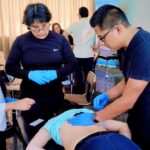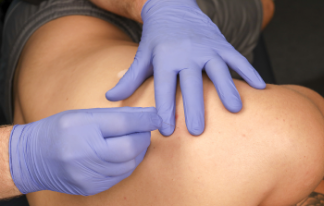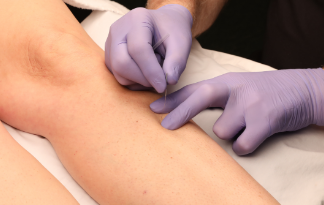During the 2023 Annual Conference of the APTA of Maryland on November 4, Dr. Jan Dommerholt had the distinct pleasure of meeting with Ms. Khadija Ali, Continuing Education Manager (Dry Needling & PT Compact) of the Maryland Board of Physical Therapy Examiners. He had sent her an email just two days earlier requesting further information about an email Ms. Ali had sent to one of our dry needling students. We are excited to share the most important aspects of our conversation, but first, let’s review just a bit of the background.
Maryland’s current dry needling regulations went into effect on October 1, 2018. As we summarized in a 2019 blog,
“The […] regulations require the completion of 40 hours of theory and 40 hours of practical instruction before a PT is allowed to use dry needling in clinical practice. […] According to the […] regulations, a physical therapist is not allowed to use dry needling at all until the completion of 80 hours of education.”
Even before the dry needling regulations were enacted, Jan Dommerholt strongly opposed the rules for various reasons, which we summarized in another blog. In a third blog, Jan suggested that the Maryland dry needling regulations may not even protect the public, which is the Board’s primary responsibility.
In other jurisdictions, a therapist can use dry needling immediately after attending a dry needling course if they limit it to muscles included in the course. There is no evidence that physical therapists who use dry needling after attending one course would pose any increased risk to the public. So why would a state board require a minimum number of hours before physical therapists can use what they have learned? The Board may inadvertently have increased the potential risk of injury. Many physical therapists take 2-3 years before completing 80 hours of continuing education in dry needling, which means that what is taught during the first course is no longer fresh in memory when the physical therapist attends the final course. After 28 years of teaching dry needling courses worldwide, Jan Dommerholt has learned that allowing PTs to use DN immediately after the first DN course makes for safer DN practice.
In the past, Jan Dommerholt objected to the regulation that “a physical therapist shall have practiced physical therapy for at least 2 years before performing dry needling in the State.” He pointed out that safe dry needling is guided by excellent anatomical knowledge. In our experience, new graduates possess a much better mastery of detailed anatomy than a PT who graduated 10-15 years ago. In other words, it appears that the Board believed it was better to wait a few years for the anatomy knowledge to fade before doing any dry needling, even though it is anatomy-driven and requires excellent anatomy knowledge……
Enough of the past!
“A Maryland-licensed physical therapist can start needling immediately in their practice under the supervision of a licensed healthcare practitioner who meets the regulatory requirements set by the Board
We are so excited to share that many of our previous concerns may not be relevant anymore. In our conversation with Ms. Khadija Ali, she recognized that in the past, the Board interpreted the dry needling regulations in a somewhat restrictive fashion. While some aspects of the dry needling regulations have not changed, one significant development is that according to Ms. Ali, a Maryland-licensed physical therapist can start needling immediately in their practice under the supervision of a licensed healthcare practitioner who meets the regulatory requirements set by the Board. Ms. Ali emphasized that “the regulations only stipulate that you are not allowed to practice dry needling in Maryland independently until after you’ve completed the 80 hours of required instruction (40 hours of hands-on training and 40 hours of theory instruction).”
So, what are those “regulatory requirements set by the Board?” According to the dry needling regulations, a licensed healthcare practitioner must have completed the requisite course work and have practiced dry needling for at least five years to function as a “supervisor.” Of interest is that “supervision” has not been defined in more detail in the dry needling regulations, and it may be preferred not to ask too many questions. Should the supervision be “in person,” or does it mean that a qualified person should be available to consult even remotely? Great questions, but likely irrelevant!
The Maryland Board of Physical Therapy Examiners is currently reviewing its dry needling regulations, and hopefully, the Board will soon release updated rules that make more sense!
Dry Needling Course Series
The Dry Needling 1 course is an excellent starting point for learning the fundamentals of dry needling therapy. With a focus on the safe and effective application of dry needling techniques, you will gain a solid understanding of myofascial trigger points, needling techniques, precautions, and how to apply these techniques in clinical practice.
The Dry Needling 2 course is an intermediate-level course that provides in-depth knowledge and hands-on training for dry needling techniques of the extremities, including the upper and lower body. By completing this course, you will expand upon the skills you acquired in the DN-1 course and better understand the application of dry needling for managing musculoskeletal pain and dysfunction.
The Dry Needling 3 course is the final course in the series and the last step before becoming a Certified Myofascial Trigger Point Therapist – Dry Needling (CMTPT/DN). This course offers an in-depth study of advanced dry needling techniques for hand muscles, several lower extremity and foot muscles, the craniofacial and craniomandibular muscles, and more.





